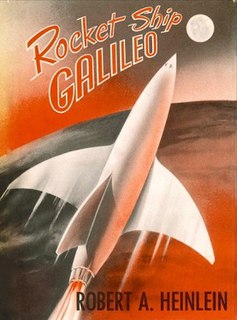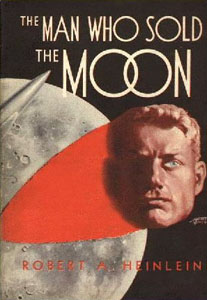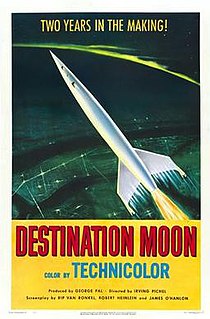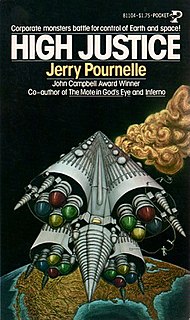Related Research Articles

Robert Anson Heinlein was an American science fiction author, aeronautical engineer, and naval officer. Sometimes called the "dean of science fiction writers", he was among the first to emphasize scientific accuracy in his fiction, and was thus a pioneer of the subgenre of hard science fiction. His published works, both fiction and non-fiction, express admiration for competence and emphasize the value of critical thinking. His plots often posed provocative situations which challenged conventional social mores. His work continues to have an influence on the science-fiction genre, and on modern culture more generally.

Rocket Ship Galileo, a juvenile science-fiction novel by the American writer Robert A. Heinlein, published in 1947, features three teenagers who participate in a pioneering flight to the Moon. It was the first in the Heinlein juveniles, a long and successful series of science-fiction novels published by Scribner's. Heinlein originally envisioned the novel as the first of a series of books called "Young Rocket Engineers". Publishers initially rejected the script, judging going to the moon as "too far out".

A Martian is an inhabitant of the planet Mars or a human colonist on Mars. Although the search for evidence of life on Mars continues, many science fiction writers have imagined what extraterrestrial life on Mars might be like.

The Moon Is a Harsh Mistress is a 1966 science fiction novel by American writer Robert A. Heinlein about a lunar colony's revolt against absentee rule from Earth. The novel illustrates and discusses libertarian ideals. It is respected for its credible presentation of a comprehensively imagined future human society on both the Earth and the Moon.
"Blowups Happen" is a 1940 science fiction short story by American writer Robert A. Heinlein. It is one of two stories in which Heinlein, using only public knowledge of nuclear fission, anticipated the actual development of nuclear technology a few years later. The other story is "Solution Unsatisfactory", which is concerned with a nuclear weapon, although it is only a radiological "dirty bomb", not a nuclear explosive device.
"Misfit" is a science fiction short story by American writer Robert A. Heinlein. It was originally titled "Cosmic Construction Corps" before being renamed by the editor John W. Campbell and published in the November 1939 issue of Astounding Science Fiction. "Misfit" was Heinlein's second published story. One of the earliest of Heinlein's Future History stories, it was later included in the collections Revolt in 2100 and The Past Through Tomorrow.
"The Green Hills of Earth" is a science fiction short story by American writer Robert A. Heinlein. One of his Future History stories, the short story originally appeared in The Saturday Evening Post, and it was collected in The Green Hills of Earth. Heinlein selected the story for inclusion in the 1949 anthology My Best Science Fiction Story. "The Green Hills of Earth" is also the title of a song mentioned in several of Heinlein's novels.
"The Long Watch" is a science fiction short story by American writer Robert A. Heinlein. It is about a military officer who faces a coup d'état by a would-be dictator.

"The Man Who Sold the Moon" is a science fiction novella by American author Robert A. Heinlein, written in 1949 and published in 1950. A part of his Future History and prequel to "Requiem", it covers events around a fictional first Moon landing in 1978 and the schemes of Delos D. Harriman, a businessman who is determined to personally reach and control the Moon.
Lester del Rey was an American science fiction author and editor. He was the author of many books in the juvenile Winston Science Fiction series, and the editor at Del Rey Books, the fantasy and science fiction imprint of Ballantine Books, along with his fourth wife Judy-Lynn del Rey.

The Past Through Tomorrow is a collection of science fiction stories by American writer Robert A. Heinlein, all part of his Future History.

Destination Moon is a 1950 American Technicolor science fiction film, independently produced by George Pal and directed by Irving Pichel, that stars John Archer, Warner Anderson, Tom Powers, and Dick Wesson. The film was distributed in the United States and the United Kingdom by Eagle-Lion Classics.
The science fiction writer Robert A. Heinlein (1907–1988) was productive during a writing career that spanned the last 49 years of his life; the Robert A. Heinlein bibliography includes 32 novels, 59 short stories and 16 collections published during his life. Four films, two TV series, several episodes of a radio series, at least one song and a board game derive more or less directly from his work. He wrote a screenplay for one of the films. Heinlein edited an anthology of other writers' science fiction short stories.

High Justice is a 1974 collection of science fiction short stories by American writer Jerry Pournelle. It was republished in an omnibus edition with Exiles to Glory in 2009 as Exile—and Glory.
The Lost Cosmonauts or Phantom Cosmonauts are subjects of a conspiracy theory alleging that some Soviet cosmonauts went to outer space, but their existence has never been publicly acknowledged by either the Soviet or Russian space authorities. Proponents of the Lost Cosmonauts theory argue that the Soviet Union attempted to launch human spaceflights before Yuri Gagarin's first spaceflight, and that cosmonauts onboard died in those attempts. Soviet military pilot Vladimir Ilyushin was alleged to have landed off course and been held by the Chinese government. The Government of the Soviet Union supposedly suppressed this information, to prevent bad publicity during the height of the Cold War.

Battle Beyond the Sun is the English-dubbed and re-edited U.S. version of Nebo Zovyot, a 1959 Soviet science fiction film. Roger Corman acquired the Soviet film for US distribution and hired a young film-school student named Francis Ford Coppola to Americanize it. It is still a tale of the "space race", of two nations competing to become the first to land a spacecraft on the planet Mars, but switches the competing nations, via the dubbing, from the USSR and the USA to the fictional future countries of North Hemis and South Hemis. The names of not only the Soviet characters, but also their performers, and the crew credits as well, were altered on the screen to American-sounding names in order to further disguise the film's origins: thus Soviet stars Aleksandr Shvorin and Ivan Pereverzev became "Andy Stewart" and "Edd Perry", and Soviet directors Mikhail Karyukov and Aleksandr Kozyr became "Maurice Kaplin" and "Arthur Corwin" - and were demoted to Assistant Director status as well. The advertising and release print's designated Director is given as Thomas Colchart; sources vary as to whom that name actually belongs.
Delos David Harriman, known as D.D. Harriman, is a character in the fiction of science fiction author Robert A. Heinlein. He is an entrepreneurial businessman who masterminded the first landing on the Moon as a private business venture. His story is part of Heinlein's Future History.
The Heinlein juveniles are the science fiction novels written by Robert A. Heinlein for Scribner's young-adult line. Each features "a young male protagonist entering the adult world of conflict, decisions, and responsibilities." Together they tell a loosely-connected story of space exploration. Scribner's published the first twelve between 1947 and 1958, but rejected the thirteenth, Starship Troopers. That one was instead published by Putnam. A fourteenth novel, Podkayne of Mars, is sometimes listed as a "Heinlein juvenile", although Heinlein himself did not consider it to be one.

Space travel, or space flight is a classic science-fiction theme that has captivated the public and is almost archetypal for science fiction. Space travel, interplanetary or interstellar, is usually performed in space ships, and spacecraft propulsion in various works ranges from the scientifically plausible to the totally fictitious.
References
- ↑ James Gifford. 2000. Robert A. Heinlein: A Reader's Companion. Sacramento: Nitrosyncretic Press Archived 2010-10-10 at the Wayback Machine . ISBN 0-9679874-1-5